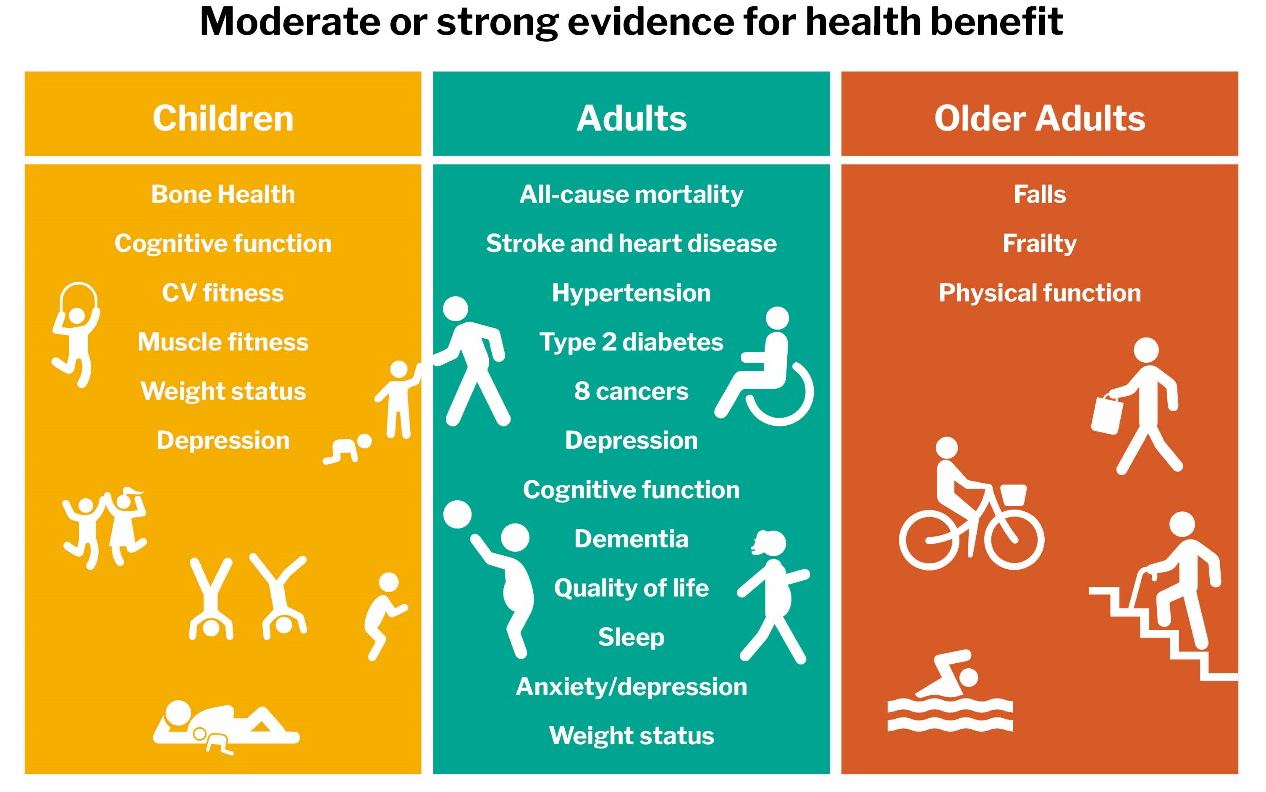All the evidence is telling us that doing more physical activity is good for us. This doesn’t mean we all have to start running, going to the gym or cycling to work (although all of these have benefits). Activity like walking around the house, doing housework or walking to meetings all count. Local initiatives such as Parkrun have mental as well as physical benefits with the opportunity to run, jog, walk, or volunteer. Being active may result in occasional injuries and even taking these in to account the benefits massively outweigh the risks.

The Chief Medical Officers’ Physical Activity Guidelines which can be found here outline the amount and type of physical activity people should be doing to improve their health.
How do we in the NHS play our part in increasing physical activity? This is the question that the Office for Health Improvement and Disparities (OHID) and Sport England asked the Horizons team. We are working to discover the answer and it is a project that has taken us in many surprising directions.
In our first meetings, we quickly realised it was going to take more than sharing the facts. We found that there are many barriers to overcome. Clinicians don’t have time to cover all of the information and don’t have access to information on what opportunities are available locally, despite the myriad of physical activity services on offer. Our workforce doesn’t have the time to focus on general health and wellbeing, especially in the middle of a pandemic, so we had to think more laterally about how to tackle the project.
We soon discovered that there was a lot of interest in our communities and in the 43 Active Partnerships that have been established around the country. Listening to stories from people working in this area, we realised that creating better ways to engage with our communities could unlock a huge amount of resource for the health and care system. Through our networks, we were lucky to find a number of people with a shared interest to work with and this led to a workshop held in Cambridge in December 2021. We hosted this alongside 4Global, a sport and health technology and data company and the report of the event Designing an Active Future has just been published.
The key recommendations from the report are:
- MAXIMISE THE IMPACT OF INTEGRATED CARE SYSTEMS. The ICSs will be the emphasis of a new NHS organisational structures to be formally introduced in July 2022. Each area will be responsible for one or two million people. How can we make them more active?
- EXPLORE INNOVATION. The focus here is greater than health and care pathways, to encompass prevention. What’s the best way of tackling the inactivity problem?
- FACILITATE GREATER CONNECTIVITY BETWEEN MORE STAKEHOLDERS. It is easy for NHS – and others too – to remain in their bubbles. Jumping between them can be immensely difficult. Nobody and everybody own physical activity. Do we all see it in the same way? We need to discover what’s getting in the way of increased physical activity for all. Is it a lack of knowledge? Competing messages? Sketchy data? Silos? An absence of connectivity?
- SHIFT THE NARRATIVE TOWARDS REDUCING HEALTH INEQUALITIES. Physical activity has a vital role to play in reducing health inequalities, and the Core20PLUS5 framework for ICSs provides a great foundation for targeted action.
- DEPLOY DATA. This would enable better decision making for and connect citizens to physical activity opportunities and support. In particular, building on the highly successful legacy of the vaccination programme for data-driven disease prevention.
- DEVELOP LEADERSHIP. Success is already being seen by those who are able to construct shared narratives based on local experience.
We are working on these now, and we are finding out that there are lots of interrelated programmes we can connect to. This will enable us to play our part in Uniting the Movement and we will share more of our findings over the next few months.
This is one of the most complex programmes I have worked on, and has used all of the expertise the Horizons team has developed over the years. It is exciting to be breaking new boundaries and great to feel that we are making progress. There is a long way to go so it was very encouraging to hear from Professor William Bird MBE after the event:
“Thank you for putting together such a stimulating two days. I have to admit expectations were low as I have been in these workshops on exactly the same subject many times for years. But this was so well organised by Steve and such an eclectic group of people that some really big, completely new insights came out.”
Read the Designing an Active Future report here.



/Passle/5a5c5fb12a1ea2042466f05f/MediaLibrary/Images/6168334917af5b10f4bf1d30/2022-04-14-15-27-52-040-62583d78f636e9115805b2d5.png)
/Passle/5a5c5fb12a1ea2042466f05f/MediaLibrary/Images/6168334917af5b10f4bf1d30/2022-08-05-09-59-36-465-62ecea08f636e906acfed639.jpg)
/Passle/5a5c5fb12a1ea2042466f05f/MediaLibrary/Images/6168334917af5b10f4bf1d30/2022-07-28-14-57-17-405-62e2a3cdf636e9180c9835cb.png)
/Passle/5a5c5fb12a1ea2042466f05f/MediaLibrary/Images/6168334917af5b10f4bf1d30/2022-07-20-10-16-56-533-62d7d618f636ea07987f6668.png)
/Passle/5a5c5fb12a1ea2042466f05f/MediaLibrary/Images/6168334917af5b10f4bf1d30/2022-07-15-09-55-32-858-62d13994f636ea1398e71aa9.jpg)